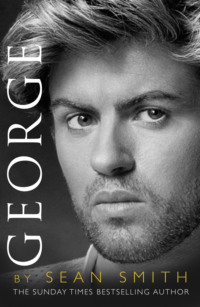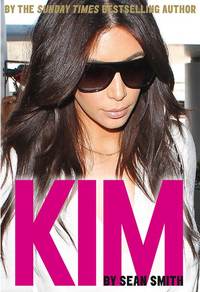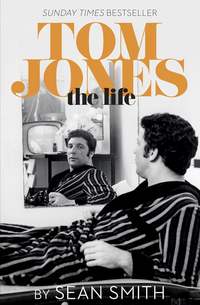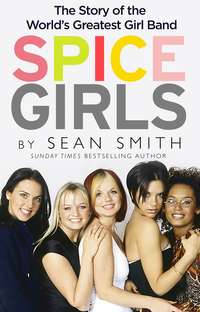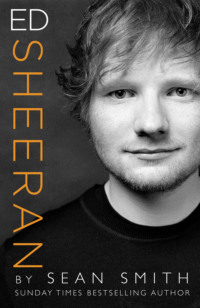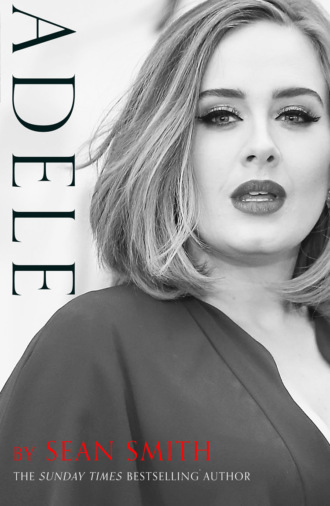
Полная версия
Adele

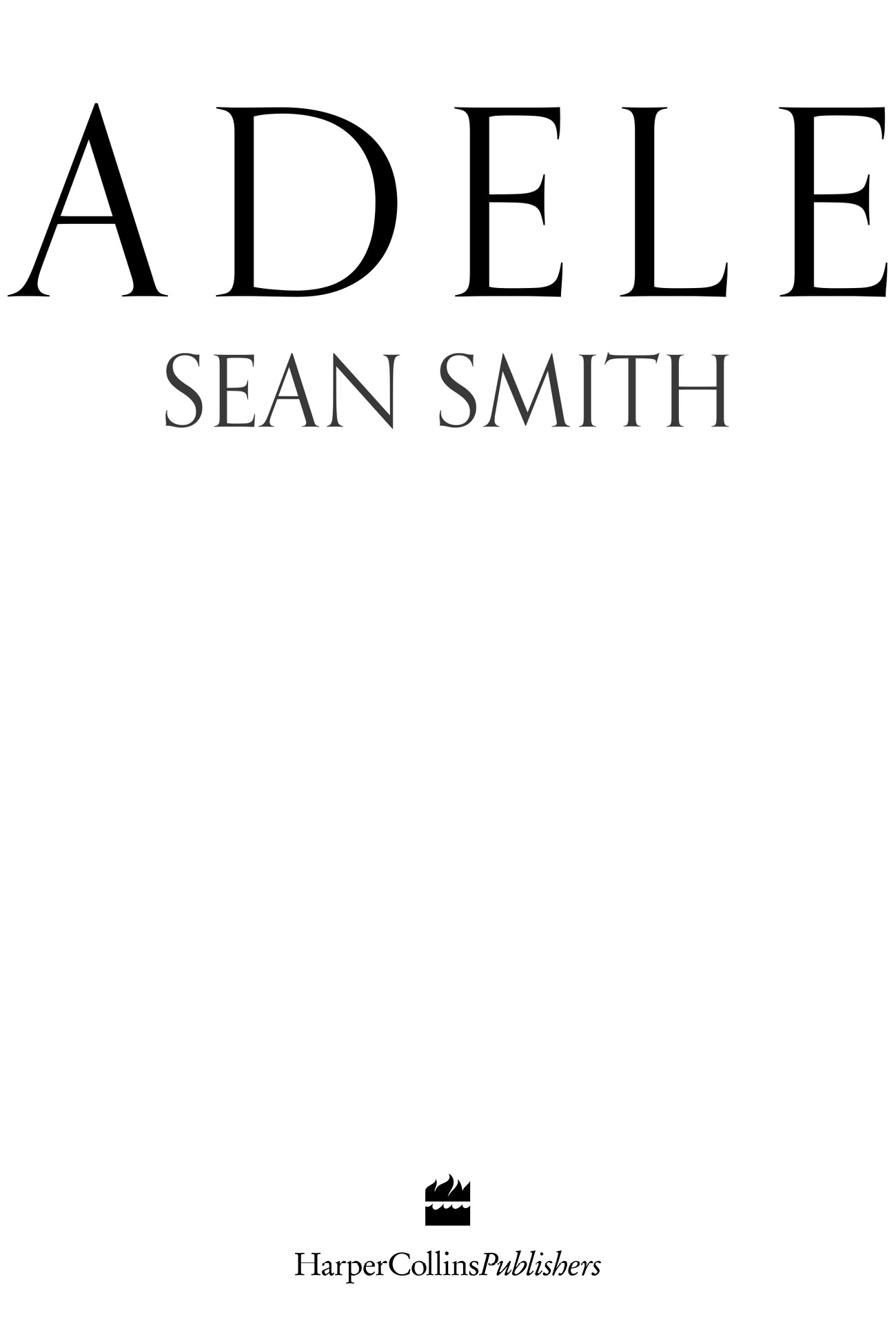
Copyright

HarperCollinsPublishers
1 London Bridge Street
London SE1 9GF
www.harpercollins.co.uk
First published by HarperCollinsPublishers 2016
FIRST EDITION
Text © Sean Smith 2016, 2017
Cover layout design © HarperCollinsPublishers 2016
Front cover photograph © Mike Marsland/WireImage/Getty Images
A catalogue record of this book is available from the British Library
While every effort has been made to trace the owners of copyright material reproduced herein and secure permissions, the publishers would like to apologise for any omissions and will be pleased to incorporate missing acknowledgements in any future edition of this book.
Sean Smith asserts the moral right to be identified as the author of this work
All rights reserved under International and Pan-American Copyright Conventions. By payment of the required fees, you have been granted the nonexclusive, non-transferable right to access and read the text of this e-book on screen. No part of this text may be reproduced, transmitted, downloaded, decompiled, reverse engineered, or stored in or introduced into any information storage retrieval system, in any form or by any means, whether electronic or mechanical, now known or hereinafter invented, without the express written permission of HarperCollins e-books.
Find out about HarperCollins and the environment at
www.harpercollins.co.uk/green
Source ISBN: 9780008155612
Ebook Edition © November 2016 ISBN: 9780008155629
Version: 2017-03-16
Also by Sean Smith
Kim
Tom Jones: The Life
Kylie
Gary
Alesha
Tulisa
Kate
Robbie
Cheryl
Victoria
Justin: The Biography
Britney: The Biography
J. K. Rowling: A Biography
Jennifer: The Unauthorized Biography
Royal Racing
The Union Game
Sophie’s Kiss (with Garth Gibbs)
Stone Me! (with Dale Lawrence)
Dedication
To Michael and Anna
Contents
Cover
Title Page
Copyright
Also by Sean Smith
Dedication
Introduction
Part One: When She Was Young
1 A Surprise Announcement
2 Spice World
3 The Miseducation of Adele Adkins
4 True Brit
5 Missing the Train
6 Daydreamer
Part Two: Sometimes It Hurts
7 XL Calling
8 Heartbreak Soul
9 Later … with Adele
10 Chasing the Dream
11 At Joe’s Pub
12 Early Life Crisis
13 En Vogue
Part Three: Feel My Love
14 The Guard Dog
15 Rolling With It
16 Vocal Discord
17 A Pregnant Pause
18 Skyfall
19 Hello Again
20 The Biggest Star on the Planet
Last Thoughts
Adele’s Stars
Life and Times
Acknowledgements
Select Bibliography
List of Searchable Terms
Picture Section
Also available by Sean Smith
About the Publisher
Introduction
The O2, London, Monday, 21 March 2016
A picture of Adele’s immaculately made-up eyes, tightly closed, with a striking pair of false lashes, illuminates an enormous screen behind the stage. Suddenly, without warning, the lights go down and the eyes open wide, creating a maelstrom of excitement and cheering. The Adele roar shakes the foundations.
‘Hello … It’s me!’ And there she is, a formidable presence, six feet in heels. She appears not on the main stage, but on a small circular platform in the centre of the audience. 20,000 people are already on their feet. Her black silk Burberry gown is speckled with hand-woven floral sequins that are instantly lit by what seem like a million mobile phones as she launches into her iconic comeback song.
How did an ordinary girl from Tottenham inspire such adulation and acclaim, mixed with a generous helping of affection? My row is full of friendly and chatty Americans, who thought it would be ‘fun’ to fly over and see her, even though she will be touring the US throughout the year. I wonder idly if there is anyone from her old neighbourhood here tonight.
Everyone seems to know the words to ‘Hello’. It’s a wall of sound, but her voice is as big as ever, refusing to be overwhelmed by the backing music or our sing-along. The track has already broken so many records. The figures are mind-boggling in an age when there’s so much choice. I read that it topped the iTunes chart in 102 countries when it was released in November 2015. I can’t name 102 countries! The problem with this song is that it will always have to be the first number at her concerts. ‘Hello’ seems a bit ridiculous as an encore anthem.
She is flanked by her security as she walks to the main stage and launches into ‘Hometown Glory’. The picture of her Dusty Springfield eyes on the big screen gives way to photographs of London. It’s a simple song, the first she ever completed, aged sixteen, and powerful in its youthful underlying message of nostalgia and empowerment.
Before we can draw breath, the blockbuster beginning continues with ‘One and Only’, arguably the best track from the record-breaking album 21. It’s smoky and soulful. Close your eyes and you can imagine one of the great divas of the past singing it in a jazz club … maybe Ella Fitzgerald or Sarah Vaughan or, best of all, Adele’s favourite singer, Etta James.
I’ve been listening to Etta a lot while I work on this book and her peerless recordings remind me so much of Adele. ‘Fool That I Am’ was on Adele’s set list when she started out, and part of me wishes it still was, but, for me, ‘One and Only’ carries the hallmark of Etta. Adele is one of those great artists who carry their influences around with them like a favourite handbag.
She needs to pause after three power songs in a row. She takes a swig from a mug containing a honey drink to soothe her voice, and starts to engage her audience in that natural, easy manner she has. It’s as if you were standing next to her in a checkout queue at Asda – although I suspect she shops at Waitrose these days.
Banter and interaction with the fans have become a feature of this tour. She started off in Belfast helping a female fan make a leap-year marriage proposal to her boyfriend. Unsurprisingly, he said yes and the story went round the world. In Manchester, she invited a twelve-year-old girl with autism to come on stage and sing ‘Someone Like You’. She was brilliant.
Tonight she invites two little girls, aged seven and eight, on to the stage and has to apologise for using the F-word. I can’t think of another star who does this. Later she asks a girl celebrating her sixteenth birthday to join her to sing a duet of the Bob Dylan classic ‘Make You Feel My Love’ from the 19 album. Adele is gracious, ‘It was really lovely to share that with you. Well done.’ This is the first time I personally have seen Adele duet.
As she says later, this is a show and not just a gig. In some ways, it’s old-fashioned entertainment, like a summertime holiday special on Great Yarmouth pier starring the late Paul Daniels, or perhaps a Christmas pantomime in which the much-missed Cilla Black would continually chat to the audience. I can imagine Adele asking us what she should do with one of her ghastly ex-boyfriends. ‘Feed him to the crocodile,’ we would shout.
She has a rare gift among modern artists of making a connection with her audience. ‘As soon as I say “Oscar”, I sound like a dickhead,’ she announces, before telling us how ‘Skyfall’ came about. At the time, she confides, she was trying to breastfeed, or ‘pumping and dumping’, as she describes it. She even encourages a Mexican wave, which is about as uncool as you can get, but emphasises her feel-good factor.
Having made sure we are on her side and part of her world, she launches into the song itself – the majesty of her voice contrasting sharply with her girl-from-Tottenham persona, all F-words and cackling laughter. I find myself looking forward to the Adele moments between the songs. She admits, ‘I’ve made a living holding onto a grudge’, and we all laugh.
She explains how she wrote ‘Million Years Ago’, one of the power ballads on 25, immediately after visiting an old friend who still lives in Tulse Hill, a mile down the road from where Adele spent her teenage years in West Norwood. She was reminded about how, every night after school, she would hang out with her friends in Brockwell Park, just off the Norwood Road, and ‘talk rubbish’. Looking back made her so sad, she wrote the song literally in minutes when she got home.
Perhaps the key moment of Adele sharing comes when she mentions Angelo, her young son, who was born in 2012: ‘He has given me so much joy, so much purpose. It has changed my life.’ I could feel she genuinely meant it.
The songs that form such an important backdrop to modern living continued, with ‘Don’t You Remember’ and ‘Chasing Pavements’ standing out. Five years ago, she tells us, things changed overnight with the performance of ‘Someone Like You’ at the BRITs. Then, it was spine-tingling. Now, it seems strangely comforting, still poignant, but with that comfy familiarity songs have when they obtain classic status. Adele says the song was her friend at a bad time. ‘It saved my life,’ she declares.
‘Fire to the Rain’ closes the main set, with Adele, thanks to special effects, caught in a downpour without an umbrella. In the old pre-mobile days, we would all have got our lighters out and let them flicker away while she sang. Struggling to light a cigarette is supposed to have given her the inspiration for the number.
The encore begins with her popping up on the small stage again. Unseen, she is carted by roadies between the two stages in a sort of wheelie bin. She starts with ‘All I Ask’, my favourite track on 25 and certainly the saddest. Fortunately, there is no sign of the sound issues that marred her performance of the song at the 2016 Grammys. It’s a breathtakingly difficult song to sing and, for me, the best of the night.
Before she sends us home happy with ‘Rolling in the Deep’, she sings another great ballad off the latest album. ‘When We Were Young’ is accompanied on the big screen by a selection of sweet, nostalgic photographs of Adele as a child – a toothless grin, a shot with her mother on the beach in South Wales.
It’s a rare glimpse of the girl who grew up to be the biggest star in the world. The pictures are just snapshots, but what was she really like, both then as a child and now as a mum?
1
A Surprise Announcement
The live video for Adele’s 2016 single ‘When We Were Young’ is a relaxed and informal affair. She is dressed in a chic black outfit and sings the nostalgic power ballad perfectly in front of her band at The Church Studios, a state-of-the-art complex in an old Victorian church in fashionable Crouch End, North London. One hundred yards away stands The King’s Head pub, a popular local boozer where, coincidentally, the Adele Adkins story begins.
These days the studios are owned by the acclaimed producer and long-time Adele collaborator Paul Epworth, with whom she co-wrote two of her best-loved songs, ‘Rolling in the Deep’ and ‘Skyfall’. Back in the 1980s, however, the studios were put on the music map of London by Annie Lennox and Dave Stewart. As Eurythmics, they recorded their debut album, Sweet Dreams, on the top floor. They went on to become one of the most successful acts of the decade, eventually buying the building and playing host to many top names, including Bob Dylan, Depeche Mode and Elvis Costello.
Down the street, on the corner of Crouch Hill, The King’s Head, which was also founded in Victorian times, became a popular and trendy bar for a young crowd keen to rub shoulders with musicians or perhaps catch a glimpse of someone famous nursing a drink in the corner. Downstairs was one of those tight, atmospheric rooms for comedy nights or for up-and-coming bands. If you were lucky, back in the day, you might have caught Dave and Annie jamming. You can imagine that Adele might have played there if she had been starting out then.
It was just the sort of place to attract an eighteen-year-old art student called Penny Adkins. She had travelled there on the bus from her parents’ house in Tottenham for a night out with friends one summer night in 1987.
Penny was tall, slender, raven-haired and stood out from the crowd. She caught the eye of most of the young men in the upstairs bar, including a broad-shouldered, handsome blond window-cleaner called Marc Evans, who had moved to London from South Wales and was carving out a good living with his round in the upwardly mobile neighbourhood.
It wasn’t love at first sight, but there was definitely some lust in the air as Marc sauntered over confidently for some light conversation and Penny’s phone number. Marc, who was twenty-five, had all the chat as a young man and enjoyed a very high success rate charming young ladies during the year he had been in London.
He and his younger brother Richard had been brought up in the popular Welsh resort of Penarth, nowadays more a Cardiff suburb than the popular seaside town it was then. Their father, John, had spotted the need for a self-employed plumber and soon was so successful he was able to buy his family a five-bedroom Victorian townhouse. ‘My parents always owned their own house through good old-fashioned graft,’ observes Marc proudly.
Marc’s mother, Rose, was a devout Christian and for many years has been a respected member of the Tabernacle Baptist Church choir. Marc was a choirboy as a youngster – ‘an Aled Jones-type until the old schmoogers dropped’. He sang at All Saints, Penarth, in Victoria Square, a ten-minute walk away. As a teenager, he harboured ambitions to sing and act and even wrote off to drama schools, but, in the end, went to a technical college in Llandaff for formal training as a plumber before joining his father’s business. Richard, meanwhile, chose a career in the police force.
Marc was enjoying the life of a Penarth playboy with a sky-blue MG roadster and a gorgeous girlfriend. When that romance went sour, his best friend, Nigel, who was studying for a degree in London, invited him to stay. Nigel’s parents were quite well off, so he wasn’t living in halls of residence but had his own place.
The two-bedroom flat in Turnpike Lane was conveniently situated a couple of miles from Crouch End in one direction and Tottenham in the other. Marc soon found work as a shop-floor manager in the Edmonton branch of Wickes, the home-improvement chain.
One day an elderly man came in and asked him for some ‘scrim’, the durable cloth used to polish windows. They got talking and the man told Marc he was earning a ‘fucking fortune’ cleaning the windows of yuppie house owners. The conversation gave Marc the germ of an idea and a few days later, on a pleasant summer evening, dressed smartly in a shirt and tie, ladder on his shoulder, he was knocking on the doors of suitable houses in Crouch End and nearby Highgate. ‘Good evening, sir. Good evening, madam, would you like your windows cleaned?’
It was £10 or £15 for twenty-minutes’ work cleaning the windows of a two-up, two-down property. By the time he met Penny later that summer, he was well on his way to earning £20,000 a year, which was a tidy sum for a young man in the 1980s.
Penny was a North London girl, not originally from Tottenham at all, but from Islington, and lived in Chalfont Road, a mile from the old Highbury football ground that closed in 2006. Her large family were, unsurprisingly, big Arsenal supporters, even though her mother and father, Doreen and John, eventually moved into a council house on the Tower Gardens Estate, off the busy Lordship Lane in Tottenham.
John Adkins was earning his living as a lorry driver when Penny, the youngest of five children, was born, but by the time their daughter was at senior school, he and his wife were working on a fruit and vegetable stall at the New Covent Garden Market in Nine Elms.
Penny was an artistic girl who showed an early talent for drawing and painting. She was never happier than when sketching in her bedroom or playing her trusty acoustic guitar. She was determined to use her gifts by studying art at university and, as many students do, she enrolled in a one-year foundation diploma in art and design at a college in Barnet.
While Penny’s family were very much working-class North Londoners, she didn’t have the rough edges. Marc explained, ‘Penny doesn’t have that sort of cockney twang. She could walk into a pub anywhere and you wouldn’t know she was from London. It’s not so much that she is posher – she is more reserved.’
Even though he had a girlfriend at the time, Marc sensed there was real chemistry between himself and the teenager. ‘She was a very, very attractive girl. She had lovely long dark hair, legs up to her neck and, what can I say, Bob’s your uncle.’
He wasted no time in ringing her to arrange a date a few days later at his favourite pub, the Punch and Judy in Covent Garden. Although it was a chance to get to know one another properly, Marc quickly realised that she wasn’t the sort of girl to jump into bed on the first date. ‘She wasn’t like that,’ he recalled.
‘It was not a big love story,’ he added. However, they continued to meet at the pub, which became ‘their’ place. Over the next few weeks, things between them got more serious and Penny agreed to stay the night at the flat in Turnpike Lane.
About two months after they met, they were passing the time at the Punch and Judy, when Penny suddenly blurted out, ‘Marc, I’m pregnant.’ He was shell-shocked at the news, but put on a brave face for his eighteen-year-old girlfriend: ‘All right, babe. No worries. We’ll sort it out.’
Despite her young age, Penny was to prove hugely resilient. There was never any question, or even discussion, about the possibility of her not keeping the child. The most pressing concern was telling Penny’s parents, who, at this point, hadn’t even met their daughter’s new boyfriend.
Despite his bravado, Marc had been brought up traditionally and insisted that he would be there when she broke the news. Penny arranged for him to join them for a Sunday lunch. ‘I told myself to “man up”, and so I went along and explained to them that I was the father. They were shocked, obviously, and asked me what I intended to do. I told them I didn’t know.’
A week later, he had made up his mind. Back at the pub, he asked Penny what she was doing for the next thirty years. ‘Do you fancy getting hitched?’ Despite being eighteen and pregnant, she said no, telling him they were too young. It was an early indication of her strength of character. Marc observed simply, ‘She was a very tenacious young girl, a very strong woman. If she’d wanted to marry me, she would have said, “Right, you’ve asked me, now let’s do it.” It wasn’t in the stratosphere, you know. She wasn’t even thinking about it. She probably saw me as a bit of a Jack the Lad and thought that this wasn’t going to work out.’
Marc still had the job of telling his own parents that they would be grandparents for the first time. He took the train back to Penarth and told them he had met a girl called Penny, who was now pregnant. His father John, a strong-minded, masculine man, wasn’t a touchy-feely chap, but took it well enough.
During the next nine months, Marc and, particularly, Penny had some important decisions to make. He moved into a shared house in Crouch End, nearer his round, when his pal Nigel got a job as a surveyor with Tower Hamlets and moved to Chingford in North East London. Penny, meanwhile, decided to give up her college course and become a full-time mum. Fiercely independent, she left home and moved into emergency accommodation for unmarried mothers on Queen’s Drive, an unappealing street near Finsbury Park Station. She also received support from the National Childbirth Trust (NCT) charity.
Marc saw her regularly, but it would be stretching it to suggest they were a devoted couple. He wasn’t the sort of man to hold her hand while she practised her breathing at antenatal classes.
Two weeks before the baby was due, he was eating breakfast at home in Crouch End when the phone rang. It was Penny’s mum Doreen. ‘Congratulations, Marc. You are the father of a baby girl.’ Despite being premature, there were no complications and the baby weighed a healthy 5lb 10½oz.
Marc dashed to the florists, bought an extravagant bunch of flowers and hopped on a bus to the North Middlesex Hospital in Edmonton, just off the North Circular Road, to see his daughter for the first time. It was 5 May 1988.
The new parents needed to decide on a name for their baby. Marc suggested Blue, his favourite colour. It was nothing to do with enjoying blues music; he just really liked the name. Penny considered that for a second or two before replying firmly, ‘I’m not calling her Blue.’
She had, in fact, already made up her mind that her daughter would be called Adele. It was an unusual choice, which perhaps was the point. In literature, Adele features in the classic novel Jane Eyre as Rochester’s young French ward. Jane takes the girl under her wing when she is employed as her governess. An art student might know that the Countess Adele was the mother of the Post-Impressionist master Toulouse-Lautrec.
For her second name, Penny chose Laurie, something suitable for either a boy or a girl. As a sop to Marc, she agreed that her third name could be Blue. He was delighted. Penny didn’t appreciate it, however, when Marc started calling his daughter Blue. She would snap, ‘Don’t call her that. Her name’s Adele.’ Penny never shortened it to Addie or Della. It was unusual in both their families for someone to have three first names. Adele Laurie Blue was certainly something to remember.
Fortunately, Penny, who had been kept in hospital for only a day, didn’t have to stay long in Queen’s Drive either. She was rehoused in a two-bedroom council flat in Shelbourne Road, Tottenham. If the wind was blowing in the right direction, she could hear the Saturday roar from the crowd at White Hart Lane. The famous Spurs ground was less than a mile away down the ironically named Park Lane, which bears no resemblance to the famous West End thoroughfare that is a byword for opulence.




